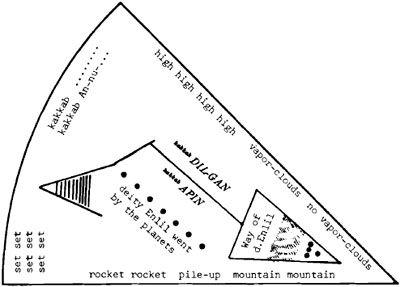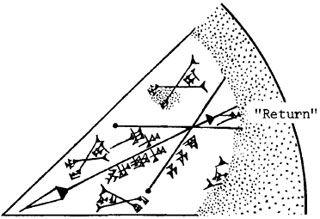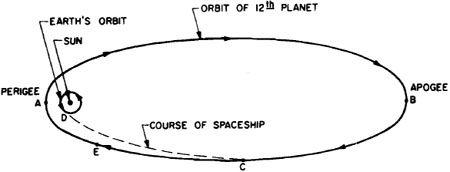The 12th Planet (44 page)
Authors: Zecharia Sitchin
Tags: #Non-Fiction, #Gnostic Dementia, #Fringe Science, #Retail, #Archaeology, #Ancient Aliens, #History

In the skies near the horizontal line, the instructions to the astronauts make sense: They are told to "set set set" their instruments for the final approach; then, as they near the ground, "rockets rockets" are fired to slow the craft, which apparently should be raised ("piled up") before reaching the landing point because it has to pass over high or rugged terrain ("mountain mountain").

Fig. 123
The information provided in this segment clearly pertains to a space voyage by Enlil himself. In this first segment we are given a precise geometric sketch of two triangles connected by a line that turns at an angle. The line represents a route, for the inscription clearly states that the sketch shows how the "deity Enlil went by the planets."
The starting point is the triangle on the left, representing the farther reaches of the solar system; the target area is on the right, where all the segments converge toward the landing point.
The triangle on the left, drawn with its base open, is akin to a known sign in Near Eastern pictographic writing; its meaning can be read as "the ruler's domain, the mountainous land." The triangle on the right is identified by the inscription
shu-ut il Enlil
("Way of god Enlil"); the term, as we know, denotes Earth's northern skies.
The angled line, then, connects what we believe to have been the Twelfth Planet—"the ruler's domain, the mountainous land"—with Earth's skies. The route passes between two celestial bodies—Dilgan and Apin.
Some scholars have maintained that these were names of distant stars or parts of constellations. If modern manned and unmanned spacecraft navigate by obtaining a "fix" on predetermined bright stars, a similar navigational technique for the Nefilim cannot be ruled out. Yet the notion that the two names stand for such faraway stars somehow does not agree with the meaning of their names: DIL.CAN meant, literally, "the first station"; and APIN, "where the right course is set."
The meanings of the names indicate way stations, points passed by. We tend to agree with such authorities as Thompson, Epping, and Strassmaier, who identified Apin as the planet Mars. If so, the meaning of the sketch becomes clear: The route between the Planet of Kingship and the skies above Earth passed between Jupiter ("the first station") and Mars ("where the right course is set").
This terminology, by which the descriptive names of the planets were related to their role in the space voyage of the Nefilim, conforms with the names and epithets in the lists of the Seven
Shu
Planets. As if to confirm our conclusions, the inscription stating that this was the route of Enlil appears below a row of seven dots—the Seven Planets that stretch from Pluto to Earth.
Not surprisingly, the remaining four celestial bodies, those in the "zone of confusion," are shown separately, beyond Earth's northern skies and the celestial band.
Evidence that this is a space map and flight manual shows up in all the other undamaged segments, too. Continuing in a counterclockwise direction, the legible portion of the next segment bears the inscription: "take take take cast cast cast cast complete complete." The third segment, where a portion of the unusual elliptical shape is seen, the legible inscriptions include
"kakkab
SIB.ZI.AN.NA ... envoy of AN.NA ... deity ISH.TAR," and the intriguing sentence: "Deity NI.NI supervisor of descent."
In the fourth segment, which contains what appear to be directions on how to establish one's destination according to a certain group of stars, the descending line is specifically identified as the skyline: The word
sky
is repeated eleven times under the line.
Does this segment represent a flight phase nearer Earth, nearer the landing spot? This might indeed be the import of the legend over the horizontal line: "hills hills hills hills top top top top city city city city." The inscription in the center says:
"kakkab
MASH.TAB.BA [Gemini] whose encounter is fixed;
kakkab
SIB.ZI.AN.NA [Jupiter] provides knowledge."
If, as appears to be the case, the segments are arranged in an approach sequence, then one can almost share the excitement of the Nefilim as they approached Earth's spaceport. The next segment, again identifying the descending line as "sky sky sky," also announces:
our light our light our light
change change change change
observe path and high ground
... flat land ...
The horizontal line contains, for the first time, figures:
rocket rocket
rocket rise glide
40 40 40
40 40 20 22 22
The upper line of the next segment no longer states: "sky sky"; instead, it calls for "channel channel 100 100 100 100 100 100 100." A pattern is discernible in this largely damaged segment. Along one of the lines the inscription says:
"Ashshur,"
which can mean "He who sees" or "seeing."
The seventh segment is too damaged to add to our examination; the few discernible syllables mean "distant distant ... sight sight," and the instructional words are "press down." The eighth and final segment, however, is almost complete. Directional lines, arrows, and inscriptions mark a path between two planets. Instructions to "pile up mountain mountain," show four sets of crosses, inscribed twice "fuel water grain" and twice "vapor water grain."
Was this a segment dealing with preparations for the flight toward Earth, or one dealing with stocking up for the return flight to rejoin the Twelfth Planet? The latter may have been the case, for the line with the sharp arrow pointing toward the landing site on Earth has at its other end another "arrow" pointing in the opposite direction, and bearing the legend
"Return."
(Fig. 124)
When Ea arranged for Anu's emissary to "make Adapa take the road to Heaven" and Anu discovered the ruse, he demanded to know:
Why did Ea, to a worthless human
the plan of Heaven-Earth disclose–
rendering him distinguished,
making a
Shem
for him?
In the planisphere we have just deciphered, we indeed see such a route map, a "plan of Heaven-Earth." In sign language and in words, the Nefilim have sketched for us the route from their planet to ours.
•
Otherwise inexplicable texts dealing with celestial distances also make sense if we read them in terms of space travel from the Twelfth Planet. One such text, found in the ruins of Nippur and believed to be some 4,000 years old, is now kept at the Hilprecht Collection at the University of Jena, in Germany. O. Neugebauer
(The Exact Sciences in Antiquity)
established that the tablet was undoubtedly a copy "from an original composition which was older"; it gives ratios of celestial distances starting from the Moon to Earth and then through space to six other planets.

Fig. 124
The second part of the text appears to have provided the mathematical formulas for solving whatever the interplanetary problem was, stating (according to some readings):
40
4
20
6
40
x 9
is
6
40
13 kasbu 10 ush mul SHU.PA
eli mul GIR sud
40
4
20
6
40
X 7
is
511 6
40
10 kasbu
11
ush 6½ gar
2
u mul GIR tab
eli mul SHU.PA sud
There has never been full agreement among scholars as to the correct reading of the measurement units in this part of the text (a new reading was suggested to us in a letter from Dr. J. Oelsner, custodian of the Hilprecht Collection at Jena). It is clear, however, that the second part of the text measured distances from SHU.PA (Pluto).
Only the Nefilim, traversing the planetary orbits, could have worked out these formulas; only they needed such data.
Taking into consideration that their own planet and their target, Earth, were both in continuous motion, the Nefilim had to aim their craft not at where Earth was at launch time but where it would be at arrival time. One can safely assume that the Nefilim worked out their trajectories very much as modern scientists map the missions to the Moon and to other planets.
The spacecraft of the Nefilim was probably launched from the Twelfth Planet in the direction of the Twelfth Planet's own orbit, but well ahead of its arrival in Earth's vicinity. Based on these and a myriad other factors, two alternative trajectories for the spacecraft were worked out for us by Amnon Sitchin, doctor of aeronautics and engineering. The first trajectory would call for the launching of the spacecraft from the Twelfth Planet before it reached its apogee (the point farthest out). With few power needs, the spaceship would actually not so much change course as slow down. While the Twelfth Planet (a space vehicle, too, even though a huge one) continued on its vast elliptical orbit, the spaceship would follow a much shorter elliptical course and reach Earth far ahead of the Twelfth Planet. This alternative may have offered the Nefilim both advantages and disadvantages.
The full span of 3,600 Earth years, which applied to tenures of office and other activities of the Nefilim upon Earth, suggests that they might have preferred the second alternative, that of a short trip and a stay in Earth's skies coinciding with the arrival of the Twelfth Planet itself. This would have called for the launching of the spaceship (C) when the Twelfth Planet was about midway on its course back from the apogee. With the planet's own speed rapidly increasing, the spaceship required strong engines to overtake its home planet and reach Earth (D) a few Earth years ahead of the Twelfth Planet. (Fig. 125)

